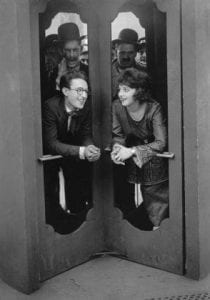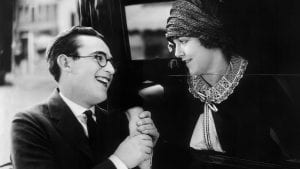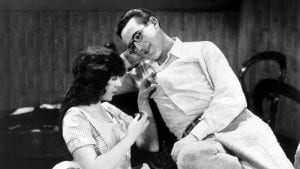
When I think of Harold Lloyd, that dazzling innovator of silent comedy, I don’t think of the iconic image of him dangling on a clock, high above a bustling city street. I don’t think of him racing a horse-drawn wagon until its wheels pop off or clinging to a girder as its moves through the air of a construction site. No, when I think of Lloyd, I think of him arranging the furniture in a moving truck so he can play house with his amused girlfriend, or sitting in a canoe as he happily sighs over the memory of the pretty girl he met on the train, or his look of heartbreak when he believes his beloved has found someone else. The filmography of Lloyd is a treasure trove of some of cinema’s finest comedic moments, moments that have continued to elicit awe and belly laughs long past their heyday, but to me, the most precious thing about Lloyd is his dreamy-eyed depiction of love.
In 1913, Lloyd made a splash as Lonesome Luke, a character not unlike Charlie Chaplin’s Little Tramp. After four years and many shorts, it was clear to Lloyd that the role was limiting and he began creating the “glasses character,” an embodiment of the modern man with a pair of horn-rimmed glasses, endless optimism, and plenty of stick-to-itiveness. (To quote his 1919 short The Marathon, “The harder you hit him, the higher he bounces.”) In Lloyd’s words, “The glasses would serve as my trade-mark and at the same time would suggest the character — quiet, normal, boyish, clean, sympathetic, not impossible to romance. I would need no eccentric make-up . . . or funny clothes. I would be an average recognizable American youth and let the situations take care of the comedy.” The change allowed audiences to identify with Lloyd and gave him the room he needed to craft the kind of character-driven narratives that would help move silent comedy toward more complex storytelling.

While he was a spectacular showman whose derring-do was defined by its balletic grace and sheer athleticism, what was important to Lloyd’s artistry wasn’t just the jaw-dropping virtuosity of his stunts — it was also the humanity he infused in his work. His characters, usually listed in the credits as The Boy, were often humiliated, mocked, or underestimated, but it would all start to turn around once he met The Girl. Buoyed by love, he would push himself to succeed and to prove himself worthy of the woman who adored him, even though we know that she already loved him before he sold his book or won the big football game or captured the villain who stole the town’s money.
The magic of Lloyd’s onscreen romances had to have been influenced by the fact that he fell for each of the three women who were his major leading ladies throughout the silent-film era. Spunky Bebe Daniels was hired by him at the start of his career and was right there with him as he developed Willie Work, Lonesome Luke, and his “glasses character.” They eventually became engaged, but Daniels’s mother and a lucrative offer from Cecil B. DeMille led to the end of their relationship in 1919. In need of a new partner, Lloyd chose Mildred Davis, a wonderful actress who proved to be a great match for him on and off the screen. The two were married in 1923 and enjoyed a long, very happy marriage until Davis’s death in 1969. Unfortunately for her, Lloyd believed she should retire once they were wed, which she reluctantly did. This opened the door for Jobyna Ralston, whose quiet loveliness perfectly complemented Lloyd’s gee-whiz persona. The co-stars had an affair, but Lloyd ultimately stayed with Davis and Ralston would go on to marry actor Richard Arlen.
What is remarkable about Lloyd’s leading ladies is that their characters were integral to the plots; they were also given the space to play different kinds of women and to join in on the gags, all of which was uncommon during this period. According to film historian Cari Beauchamp, “The female characters were much more important, much more three-dimensional than in many of the other films that were being made at that time.” Part of what Lloyd liked about the “glasses character” was the ability it gave him to pick and choose any social status and occupation he wanted, thus affording him a wider range of where he could take the character. His leading ladies had the same mobility; wherever he went, they could follow and adapt.
For the Lloyd hero, love and ambition are intertwined, making his eventual victory all the more rewarding for him and for the viewer. The Boy and The Girl may be ordinary, but their romance feels extraordinary. In most, if not all, of Lloyd’s feature films, there is the moment of romantic euphoria, a manifestation of his newfound love that is both adorable and funny. One of the best examples is in The Kid Brother. After meeting Ralston in the woods, Lloyd is so smitten that he forgets to ask her name or where he can find her. As she walks back into town, the camera follows him hurriedly climbing a tree, stopping only to yell his questions and hear her shouted answers as she gets further and further away. Once they finally say goodbye, he swings on a limb with delight, causing him to fall back down the tree and land with a thud on the ground. Still in a lovesick daze, though, he doesn’t mind the tumble, choosing instead to absentmindedly pull the petals off of a nearby flower. Devised by Lloyd and shot with the camera on an elevator-like platform, it’s the kind of scene that few filmmakers could do with such deep earnestness and ebullience.
That’s the ecstasy of Harold Lloyd for me. Every single film of his, be it one reel or six, makes me grin from ear to ear as I clap my hands with joy or sigh with satisfaction. His love stories can be so simple — boy meets girl, boy becomes hero, boy gets girl — and yet they are so pure and enchanting. In my mind, few romantic comedies have reached the highs of Dr. Jack helping the Sick-Little-Well-Girl escape her greedy, gaslighting doctor, or the glorious final shot of The Kid Brother, or the entirety of Girl Shy, which became one of my favorite films the instant I laid eyes on it. For Harold Lloyd, love leaves you weak-kneed, but it also emboldens you and amplifies the very best parts of yourself. It is everything.
What could be more timeless and irresistible than that?

The Kid Brother will be in the IU Cinema Virtual Screening Room from April 21 to May 5 as part of the Sunday Matinee Classics series, which will be the Any Day Matinee Classics series this semester. You will be able to stream the film to the device of your choosing via a link and password which will only be provided through our Weekly Email. You must be subscribed to our Weekly Email to receive the film’s link and password.
IU Cinema has previously screened the Lloyd classics Safety Last in 2013 for the City Lights Film Series and Speedy in 2019 with accompaniment by Alloy Orchestra.

Michaela Owens is thrilled to be the editor of A Place for Film, in addition to being IU Cinema’s Publications Editor. An IU graduate with a BA in Communication and Culture and an MA in Cinema and Media Studies, she has also been a volunteer usher at IU Cinema since 2016. She never stops thinking about classic Hollywood, thanks to her mother’s introduction to it, and she likes to believe she is an expert on Katharine Hepburn and Esther Williams.


